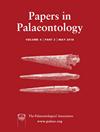Evidence for the evolutionary history and diversity of fossil sweetgums: leaves and associated capitate reproductive structures of Liquidambar from the Eocene of Hainan Island, South China
IF 2.2
2区 地球科学
Q1 PALEONTOLOGY
引用次数: 0
Abstract
Extant species of Liquidambar L. exhibit a disjunct distribution between western and eastern Asia and eastern North America to Central America, with the highest species diversity being in China. In this study, two new species of Liquidambar are described from the Eocene of Hainan Island, South China: L. hainanensis on basis of the leaf fossils, and L. ovoidea based on compressions of infructescences. The co-occurrences of L. hainanensis leaves, associated infructescences of L. ovoidea and dispersed pantoporate pollen grains have the combination of morphological features peculiar to the genera Liquidambar and former Semiliquidambar and Altingia. This is considered further palaeobotanical justification for the placement of these three genera into a single genus, Liquidambar, proposed earlier based on molecular markers. Our data provide evidence for the occurrence of an ancestral polymorphic group of Liquidambar species (L. maomingensis with associated capitate infructescences, L. bella, L. hainanensis and L. ovoidea) during the Eocene in South China, and corroborate the view that South China could have been a centre of Liquidambar speciation during the Eocene. The morphological similarity of L. hainanensis leaves to those of the extant species L. orientalis from Western Asia and the North American L. styraciflua may support the importance of both the North Atlantic Land Bridge and the Bering Land Bridge for the dispersal of Liquidambar. Analysis of fossil species of Liquidambar from eastern Asia also contributes to further understanding of patterns in the taxonomic diversity and evolutionary history of this genus.化石红豆杉进化史和多样性的证据:华南海南岛始新世枫香树的叶片和相关头状生殖结构
枫香树现存物种分布于亚洲西部和东部、北美洲东部至中美洲之间,其中中国的物种多样性最高。本研究描述了华南海南岛始新世的两个枫香树新种:根据叶化石描述了 L. hainanensis,根据果序的压缩描述了 L. ovoidea。同时出现的海南树叶、L. ovoidea 的相关果序和分散的泛粉花粉粒具有枫香属、前半枫香属和 Altingia 属特有的形态特征。这被认为是早先根据分子标记将这三个属归入一个属--Liquidambar--的进一步古植物学依据。我们的数据为华南地区始新世时期出现的枫香属物种祖先多态群(茂名枫香属(L. maomingensis)及相关的头状果序、贝拉枫香属(L. bella)、海南枫香属(L. hainanensis)和敖包枫香属(L. ovoidea))提供了证据,并证实了华南地区可能是始新世时期枫香属物种分化中心的观点。海南枫叶与西亚现生种东方枫叶和北美枫叶的形态相似,这可能证明了北大西洋陆桥和白令陆桥对枫香树传播的重要性。对亚洲东部枫香树化石物种的分析也有助于进一步了解该属的分类多样性和进化历史。
本文章由计算机程序翻译,如有差异,请以英文原文为准。
求助全文
约1分钟内获得全文
求助全文
来源期刊

Papers in Palaeontology
PALEONTOLOGY-
CiteScore
4.50
自引率
4.30%
发文量
55
期刊介绍:
Papers in Palaeontology is the successor to Special Papers in Palaeontology and a journal of the Palaeontological Association (www.palass.org). The journal is devoted to the publication of papers that document the diversity of past life and its distribution in time and space.
Papers in Palaeontology is devoted to the publication of papers that document the diversity of past life and its distribution in time and space. As a sister publication to Palaeontology its focus is on descriptive research, including the descriptions of new taxa, systematic revisions of higher taxa, detailed biostratigraphical and biogeographical documentation, and descriptions of floras and faunas from specific localities or regions. Most contributions are expected to be less than 30 pp long but longer contributions will be considered if the material merits it, including single topic parts.
The journal publishes a wide variety of papers on palaeontological topics covering:
palaeozoology,
palaeobotany,
systematic studies,
palaeoecology,
micropalaeontology,
palaeobiogeography,
functional morphology,
stratigraphy,
taxonomy,
taphonomy,
palaeoenvironmental reconstruction,
palaeoclimate analysis,
biomineralization studies.
 求助内容:
求助内容: 应助结果提醒方式:
应助结果提醒方式:


